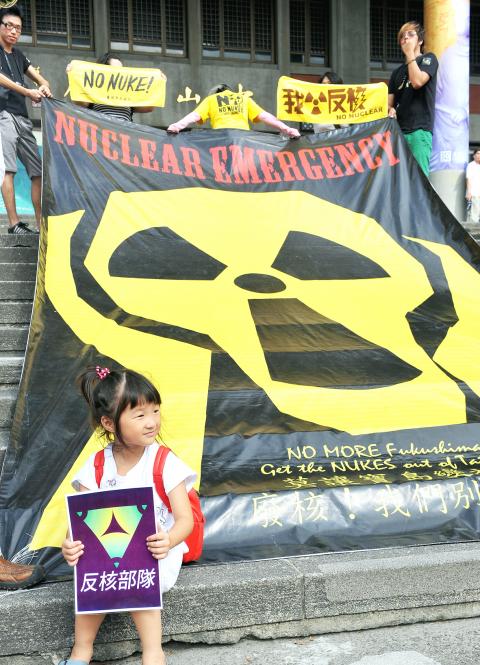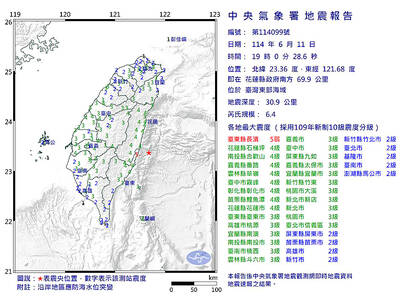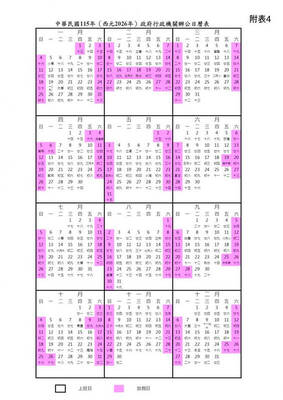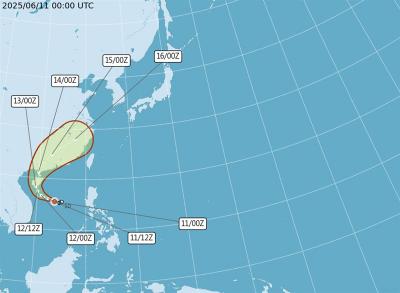Anti-nuclear groups said they doubted there was a workable plan in place to evacuate 6 million people within the 30km evacuation zones of the first and second nuclear power plants, calling the government’s safety claims as absurd as an emergency exit-deprived Taipei 101 guaranteeing the safety of visitors.
Nuclear safety is not restricted to the nuclear engineering techniques within the plants, said Japan and Taiwan Exchange Association spokesman Chen Hong-mei (陳弘美), who organized a panel discussion about nuclear safety held yesterday called “No Nukes for Earthquake Countries.”
Three Japanese anti-nuclear advocates were on the panel, one of whom was Idogawa Katsutaka, the mayor of Futaba city, which is close to the Fukushima Dai-ichi Nuclear Power Station.

Photo: Chien Jung-fong, Taipei Times
Chen said that a Japanese research group, the Association for the Research of Transportation Problems and Human Rights, published a report in January on the evacuation time needed for people living within the 30km exclusion zones of the nuclear power plants in Japan.
The report said that the region that would require the most time to evacuate was one that has 750,000 residents, requiring at least 142 hours (six days) for full evacuation.
Chen said that there are 6 million people living within the 30km evacuation zone around Taiwan’s Jinshan (金山) and Kuosheng (國聖) nuclear power plants.
Murakami Tatsuya, then-mayor of Tokaimura village during the Tokaimura Criticality Accident in 1999, oversaw the evacuation of 310,000 residents living within a 10km radius of the Tokaimura nuclear power plant. He called a plan to evacuate the 1 million people within the 30km evacuation zone of Tokaimura plant “impossible.”
Idogawa, who was exposed to a high level of radiation while trying to get people out of the town, said that he was deceived.
“Nuclear power plants cannot continue operations without relying on lies,” he said, adding that before the Fukushima accident, Tokyo Electric Power Co and the Japanese government had repeatedly assured him that accidents would not happen.
He was told by a Swedish nuclear power expert that it would take 500 years before Futaba residents could return to their homes.
Taipei mayoral aspirants Ko Wen-je (柯文哲) and Wellington Koo (顧立雄) were among the participants at the discussion.
Koo said that as the chairman of the Taiwan Association for Human Rights, which has always been anti-nuclear, he has taken a firm stance against nuclear power.
“After the tragedy at Fukushima, the problem of nuclear power has become palpable. It is no longer an issue about generational justice, but about our right to existence,” he said.
It has been reported that out of 34 nuclear reactors operating in earthquake-prone regions around the world, 30 are in Japan and Taiwan.
“All eight reactors in Taiwan are on the list,” Koo said, calling the government’s “no Fourth Nuclear Power Plant without nuclear safety” guarantee upheld by KMT Mayor hopeful Sean Lien (連勝文) “an empty promise.”
Ko panned the Ma administration as a “green-card government” with officials being able to flee the nation if a catastrophe occurs.
“The question of what to do with nuclear power plants is extremely simple when we take future generations into consideration. Only those who plan their future in four-year units would agree to the building of the plant,” he said.

A magnitude 6.4 earthquake struck off the coast of Hualien County in eastern Taiwan at 7pm yesterday, the Central Weather Administration (CWA) said. The epicenter of the temblor was at sea, about 69.9km south of Hualien County Hall, at a depth of 30.9km, it said. There were no immediate reports of damage resulting from the quake. The earthquake’s intensity, which gauges the actual effect of a temblor, was highest in Taitung County’s Changbin Township (長濱), where it measured 5 on Taiwan’s seven-tier intensity scale. The quake also measured an intensity of 4 in Hualien, Nantou, Chiayi, Yunlin, Changhua and Miaoli counties, as well as

Taiwan is to have nine extended holidays next year, led by a nine-day Lunar New Year break, the Cabinet announced yesterday. The nine-day Lunar New Year holiday next year matches the length of this year’s holiday, which featured six extended holidays. The increase in extended holidays is due to the Act on the Implementation of Commemorative and Festival Holidays (紀念日及節日實施條例), which was passed early last month with support from the opposition Chinese Nationalist Party (KMT) and Taiwan People’s Party. Under the new act, the day before Lunar New Year’s Eve is also a national holiday, and Labor Day would no longer be limited

The first tropical storm of the year in the western North Pacific, Wutip (蝴蝶), has formed over the South China Sea and is expected to move toward Hainan Island off southern China, the Central Weather Administration (CWA) said today. The agency said a tropical depression over waters near the Paracel and Zhongsha islands strengthened into a tropical storm this morning. The storm had maximum sustained winds near its center of 64.8kph, with peak gusts reaching 90kph, it said. Winds at Beaufort scale level 7 — ranging from 50kph to 61.5kph — extended up to 80km from the center, it added. Forecaster Kuan Hsin-ping

COMMITMENTS: The company had a relatively low renewable ratio at 56 percent and did not have any goal to achieve 100 percent renewable energy, the report said Pegatron Corp ranked the lowest among five major final assembly suppliers in progressing toward Apple Inc’s commitment to be 100 percent carbon neutral by 2030, a Greenpeace East Asia report said yesterday. While Apple has set the goal of using 100 percent renewable energy across its entire business, supply chain and product lifecycle by 2030, carbon emissions from electronics manufacturing are rising globally due to increased energy consumption, it said. Given that carbon emissions from its supply chain accounted for more than half of its total emissions last year, Greenpeace East Asia evaluated the green transition performance of Apple’s five largest final